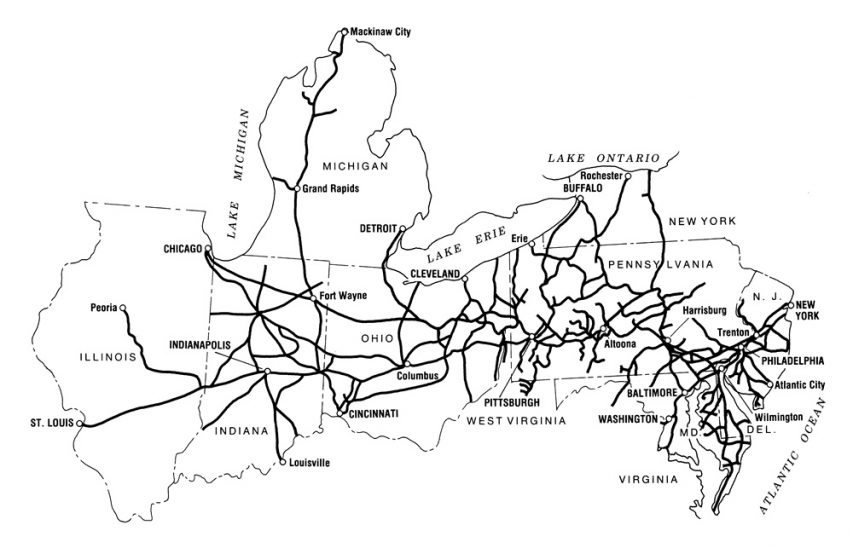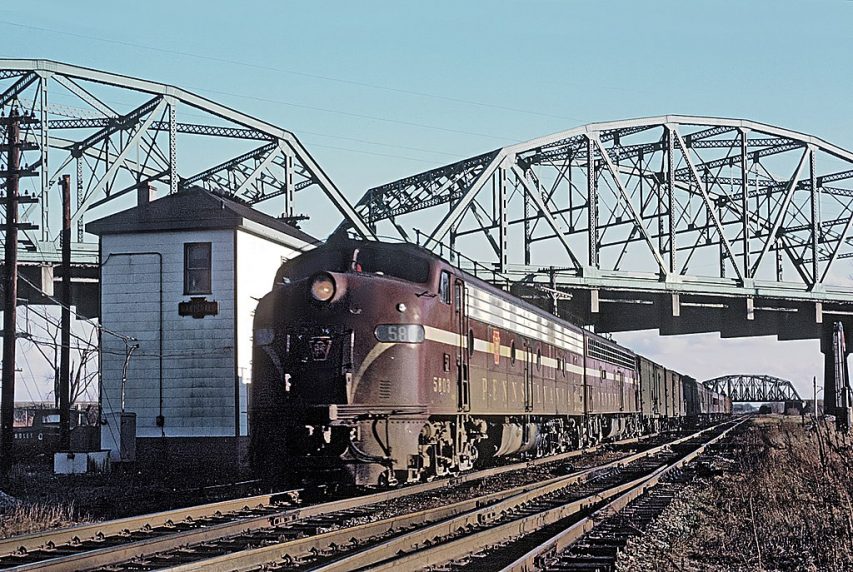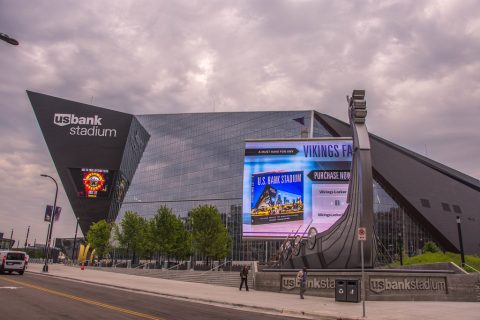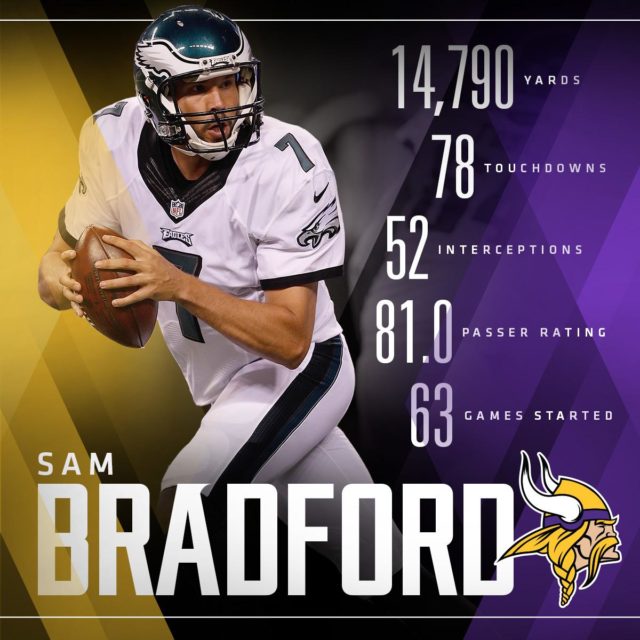 Sunday’s match-up between two 3-2 teams had the hometown Vikings slightly favoured by the bookmakers at 3 (most NFL games assume a three-point advantage to the home team, so this indicates the teams are seen to be pretty equal overall). The Eagles, coming off a high-scoring beat-down of the hapless New York Jets, hoped to carry on their winning ways, while the Vikings wanted to keep the momentum going from last week’s win against the New York Giants.
Sunday’s match-up between two 3-2 teams had the hometown Vikings slightly favoured by the bookmakers at 3 (most NFL games assume a three-point advantage to the home team, so this indicates the teams are seen to be pretty equal overall). The Eagles, coming off a high-scoring beat-down of the hapless New York Jets, hoped to carry on their winning ways, while the Vikings wanted to keep the momentum going from last week’s win against the New York Giants.
The first quarter went as well as the Vikings could have hoped, keeping the ball away from Carson Wentz and the Eagles’ offence: at one point near the end of the first quarter, the Vikings had almost a 5:1 advantage in time of possession. Kirk Cousins opened the scoring with a pass to Adam Thielen in the corner of the end zone, and Dan Bailey scored a field goal on the Vikings’ second possession to take a 10-0 lead in the first frame. Philadelphia started to show signs of life during the second quarter, but the score at the half was 24-10, with the Eagles set to receive the second-half kickoff … after the Eagles attempted an end-of-half fake field goal that ended with an athletic Everson Griffen interception.
Of course, no game is complete without at least one head-scratcher, as the TV broadcast initially indicated a Philadelphia safety before correcting to a Vikings touchdown reception by Stefon Diggs (one of three on the day):
To start the second half, Philadelphia managed to narrow the Vikings’ lead to only four points before Minnesota found the accelerator again and ended up with a very comfortable 18-point winning margin. Overall, it was a good game, although there were a few things missing: the early running game and all the yellow hankies we’ve grown so familiar with littering the field. Kirk Cousins finished the day with 333 yards passing (22 completions on 29 attempts) with four touchdowns and one interception. Stefon Diggs had his biggest day of the 2019 season so far with 167 receiving yards with three touchdowns and two drops, one of which was intercepted by former Viking safety Andrew Sendejo. Adam Thielen had (for him) a quiet day, receiving for 57 yards on six throws and the opening TD. Dalvin Cook was mostly kept in check by the Eagles’ number-one rushing defence, tallying 16 runs for 41 yards and one TD. Backup running back Alexander Mattison had more luck, gaining 63 yards on 14 rush attempts, but also had a late fumble down near the Eagles’ goal line.
Judd Zulgad contemplates the bulletin board material a current member of the Iggles provided for Kirk Cousins:
Philadelphia linebacker Zach Brown attempted to plant doubt between the ears of Vikings quarterback Kirk Cousins when given the opportunity on Friday.
“I think every defense is going to want that guy to throw the ball,” said Brown, who was a teammate of Cousins’ in Washington in 2017. “For me, that’s probably the weakest part of their offense is him. Everything else is good. They’ve got a good running game, probably one of the best in the league. They have real good receivers. You just want them to pass the ball. You want Kirk Cousins to get it in his hands.”
Brown was gambling Cousins’ reaction to his comments would be to over-think them and potentially fall apart on Sunday. Turns out Brown didn’t know Cousins as well as he thought he did and Cousins, well, he claimed he didn’t even know about Brown’s comments until after the fact. Not only did Cousins not fall apart but he put together one of his best games since signing a three-year, $84 million contract with the Vikings in March 2018.
Cousins completed 22 of 29 passes for 333 yards with four touchdowns, one interception and a 138.4 passer rating in a 38-20 victory that put the Vikings at 4-2 and will silence the Cousins’ critics (this one included) for the time being.
“I just found out about (Brown’s comments) about 20 minutes ago,” Cousins said after the game. “(An ESPN reporter) talked to me on the field and mentioned it. I didn’t even know what (Brown) said. I really do stay in here and not read anything and that’s for my best interest. Zach was a teammate in Washington, he’s one of the better linebackers I played with or against. I have a lot of respect for him. If you’re trying to write a story about how it was a motivator this week, it wasn’t because I didn’t know about it. Ignorance is bliss. I just put my head down and work and prepare the same way every week and not try to ride the roller coaster.”
At the Daily Norseman, Ted Glover provides an uncharacteristically upbeat Stock Market Report on the Eagles game:
Junk Bonds
No one. So, there were some players that had some bad individual plays, but not over the course of the whole game. Xavier Rhodes comes to mind once or twice, Pat Elflein had a bad whiff that led to a sack, and Mattison had a fumble late, for example. Overall, though, I don’t think there was anyone that stood out so poorly that deserved a junk bond. If you disagree, let me know.
Buy/Sell
Buy: Something snapped in the Vikings after the Bears game. After the Chicago shitshow, it felt like the Vikings were one bad game or locker room outburst from spiraling out of control. But, something different happened. I don’t know what it was — a locker room speech, the Diggs and Thielen comments, or something else, but whatever it was worked, and the Vikings have gone on a a little bit of a tear, kicking the hell out of two NFC East teams in a row.
Sell: It’s going to last. As much as I would love to see it happen, the chances the Vikings go 14-2 are remote. So when the next loss does come, I will really be looking at how the Vikings react, and how they rebound the following game.
Buy: Anthony Barr fumble recovery. After the Vikings had gone up 38-20, there was still enough time left for the Eagles to rally, and they had proved earlier in the game that they could, in fact, do just that. But when it looked like the Eagles were driving, Eric Kendricks stripped the ball from Zach Ertz at the Vikings 28, Barr scooped it up, and essentially put the dagger in Philly’s comeback hopes.
Sell: Anthony Barr pass coverage. Of course, Barr helped breathe life into their comeback. Down 24-10 Barr let Miles Sanders get behind him for a 45 yard gain, and that got the ball down to Vikings 4. Two plays later the Eagles were in the end zone, it was 24-17, and sphincters throughout the Upper Midwest tightened.
Buy: 88 yard drive to ice the game. So here’s the situation. It was 31-20, and even though the Vikings defense had stopped the Eagles a couple times, and the Vikes had added a second half TD, it still felt like Philly wasn’t out of it. After a big sack by Kendricks and Mac Alexander stopped the Eagles around midfield, Philly punted and [the Vikings] took over at the 12. The Vikings went on an epic 8 play, 88 yard drive that took almost five minutes of game clock, capped by a Dalvin Cook one yard run to make the score 38-20, and it put the game out of reach. It was a killer instinct that has been lacking from this team for the better part of two seasons, and it was really nice to see.
Sell: Closing the Eagles out at 24-3. As awesome as that drive was, it didn’t come until after the Eagles had closed the score from 24-3 to 24-20. The offense started out en fuego, but, not unexpectedly, cooled off a bit. And just when they cooled off a bit, the Vikes defense went into a bit of a hibernation. Broken coverages, missed tackles, and a lack of pressure allowed the Eagles to rally, and before you could lean over and tell a bad Ole and Lena Joke, it was 24-20 with over 20 minutes of game time left. Both the offense and defense snapped out of it, but it was still a concerning lapse on both sides of the ball, and something the Vikings can’t do week in and week out.






 Sunday’s match-up between two 3-2 teams had the hometown Vikings slightly favoured by the bookmakers at 3 (most NFL games assume a three-point advantage to the home team, so this indicates the teams are seen to be pretty equal overall). The Eagles, coming off a high-scoring beat-down of the hapless New York Jets, hoped to carry on their winning ways, while the Vikings wanted to keep the momentum going from last week’s win against the New York Giants.
Sunday’s match-up between two 3-2 teams had the hometown Vikings slightly favoured by the bookmakers at 3 (most NFL games assume a three-point advantage to the home team, so this indicates the teams are seen to be pretty equal overall). The Eagles, coming off a high-scoring beat-down of the hapless New York Jets, hoped to carry on their winning ways, while the Vikings wanted to keep the momentum going from last week’s win against the New York Giants.
 (@ArifHasanNFL)
(@ArifHasanNFL) 



